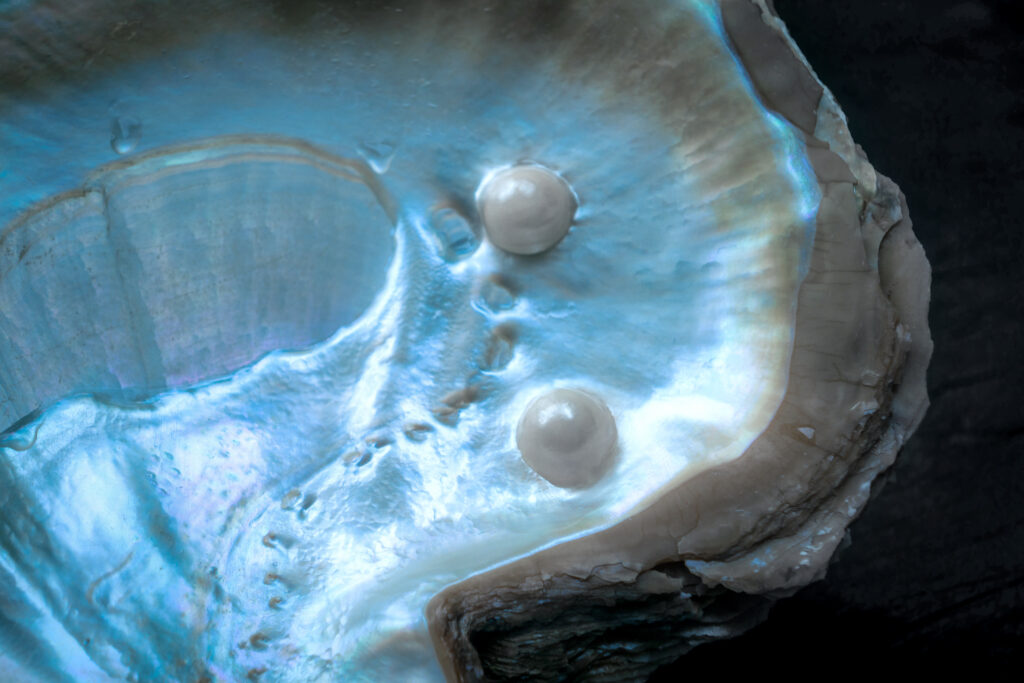Natural pearls occur in mollusks such as oysters when an irritant such as sand enters its shell, but what are the odds of this actually happening?
It’s estimated that the odds of finding a pearl in an oyster is around 1 in 10,000, but these often won’t be jewelry-grade pearls. This rarity is the reason behind a massive push for ‘farmed’ pearls, which can be produced at will.

Read on to learn more about pearls, how they occur, and what they’re worth.
Diamond In The Rough, Pearl In The Oyster
As a species, we’ve adored the smooth, shining beauty of pearls for thousands of years, tracing their history back to the ancient Persians and Egyptians. They’ve long been admired for their mesmerizing appearance, and mother-of-pearl – the material they’re made from – has been used by humans for some six thousand years.
Although the decorative use of mother-of-pearl, also known as nacre, was popular before pearls were discovered, the latter eventually overtook the former. It’s likely ancient cultures almost worshipped pearls, being as they were a totally natural and dramatically rare occurrence.
They’re in a league of their own, being the only ‘gem material’ forged entirely within a living creature. Pearls aren’t developed within the earth over the course of millions of years, and they require almost no cutting or polishing before they’re ready to be used.
Natural pearls occur in all forms of mollusk, but we typically hear about them being found in oysters. They’re the result of the introduction of a foreign body – such as a piece of sand – into the protective shell layer of a mollusk.
When this irritant or foreign body breaches the exterior of the mollusk, a natural defense mechanism kicks in. The mollusk secretes a mixture of substances that combine to create nacre, the same material used to line its shell.
This substance envelopes the irritant, wrapping it in layer after layer of hard, shining material. In an ideal world, these layers are applied in an intensely uniform fashion, resulting in a perfectly spherical, smooth, and beautiful pearl.
However, this process isn’t always perfect, and it absolutely is not guaranteed to even take place at all. It’s thought that the odds of finding a pearl in an oyster are around 1 in 10,000, making them extremely rare in the wild.
If You Can’t Find One, Make One
As pearls are so rare but so desirable and coveted, efforts have been made to essentially farm them. These ‘cultured’ pearls are created in the same way as they are in the wild, but the process is forced and not at all natural.
When a person attempts to culture a pearl, they’ll introduce an irritant to the mollusk’s shell, implanting it in the ‘mantle’ of the outer layer. Then, hopefully, the mollusk will begin to secrete that all-important material that ultimately results in a pearl being produced.
At that point, it can take anywhere from six months to four years for a pearl to fully form, depending on the thickness of the nacre. Although, it’s still a guessing game until the pearl has developed completely, as so few of these pearls are of gem quality.
You can learn much more about the life of a pearl in another article we wrote, exploring what happens to pearls as they age.
There have been many instances where people have found pearls in oysters that they’ve ordered in a restaurant. In most cases, these pearls will make for an exciting find, but they typically won’t be worth a huge sum.
Among the gem industry, the value of a pearl fluctuates massively based on a range of factors. Firstly, there’s the type of pearl, of which there are five: Tahitian, Akoya, Freshwater, South Sea, and Natural Saltwater.
The most valuable type is the Tahitian pearl, famed for its dark, almost black, coloring. These pearls are indigenous to Fiji, French Polynesia, and the Cook Islands, and their price point typically starts at around two hundred dollars.
However, these pearls can command a price of more than thirty-six thousand dollars for the finest examples. Of course, these are extremely few and far between, as is the case with any pearl.
The least desirable pearls are the Freshwater variants, also the most widely-available pearl in the world. It might seem surprising, but at the lowest end of the spectrum, a Freshwater pearl is worth just twenty dollars.
So, while it might be a considerably rare experience finding a pearl inside an oyster, it isn’t necessarily guaranteed to be a lucrative one.
